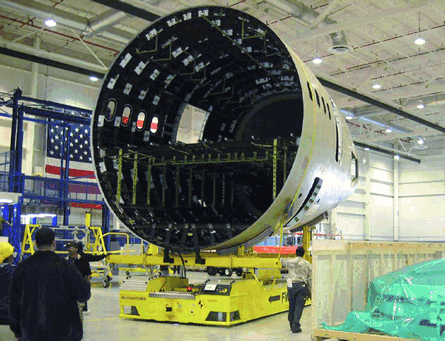Far from the 787 final assembly line, two facilities in north Charleston, South Carolina were established to manufacture and integrate fuselage barrels for the Dreamliner. The two factories were operated by Vought Aircraft Industries and Global Aeronautica, a joint venture between Alenia Aeronautica and Vought.
The Vought plant fabricates the two aft barrels of the fuselage, Sections 47 and 48. Next door, Global Aeronautica integrates structural sections from Japan and Italy. Alenia delivers sections 44 and 46 from Grottaglie, Italy, while Fuji and Kawasaki Heavy Industries deliver Section 43 and Section 45/11, the centre wing box and main landing gear wheel well. The four sections are joined, stuffed with systems, wiring and ducting then shipped to Everett.
 |
|---|
© Boeing |
Each site was designed as an ultra-lean facility with a highly trained staff capable of signing off on the airworthiness of their own work. Boeing saw this as the next generation of aerospace manufacturing teams of "super mechanics" would build the 787. Each "super mechanic" would hold multiple manufacturing certifications to expedite the production process to build a greater degree of quality assurance directly into the integration of the aircraft.
But rather than a highly trained staff, Global Aeronautica and Vought were peopled by mechanics whose expertise lay outside aerospace. One Boeing veteran says that some staff had no manufacturing background.
The skills that staff brought to the 787 were not applicable to building aircraft. "The folks working on the floor say if we can build a fire truck or a fork lift, we can build an aircraft," says a veteran Boeing engineer in Charleston. "It doesn't work that way. It's an aerospace state of mind, and it isn't here."
Lack of expertise among the workforce caused quality workmanship to suffer, resulting in time-consuming fixes that had to be completed in Charleston, delaying delivery or slowing final assembly.
"They were really putting their best foot forward," the engineer says. "But it didn't matter at that point. When you're [messed] up, you're [messed] up."
During the 10 October delay announcement, Scott Carson said: "I like the Charleston factory. I like having it next to Vought. We like having Vought as a partner. If there's a lesson learned, it might be you'd start earlier and do a little more training, perhaps with our people there. But there's no fundamental flaw in Charleston."
Global Aeronautica built in "locked steps" for assembly that must be completed before future milestones can take place. As the centre fuselage sections transition through the assembly process, each centre section must pass through assembly "cells". The first cell is where structural sections are joined and aligned and the second cell is for continued assembly and early installation of wiring and insulation.
These "locked steps' prevented the centre fuselage from being moved between assembly cells unless a certain percentage of fasteners are installed. With a shortage of fasteners plaguing the programme, fuselage sections were left frozen until the milestones were met.
Across the supply chain, there was no uniform means of procurement, further complicating the shortage of parts.
On 28 March, Boeing acquired Vought's 50% stake in Global Aeronautica to gain direct oversight over the integration process, while allowing Vought to focus on manufacturing aft fuselage sections.
Source: Flight International
















